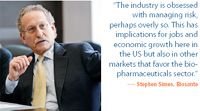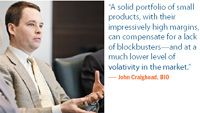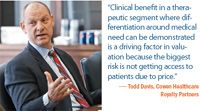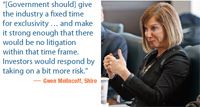2011 Dealmakers Outlook
With Yankee stadium as the backdrop, Pharm Exec convened its annual panel of eight business development experts to crack the bat on best practice in licensing and M&A for the year ahead.
With Yankee stadium as the backdrop, Pharm Exec convened on March 29 its annual panel of eight business development experts to crack the bat on best practice in licensing and M&A for the year ahead. What follows is a summary of the group's discussion, with the major conclusion being that the quest continues for that rare triple play: finding a good, well-differentiated asset; forging a productive partnership around it; at a price that compensates for the warp speed curve ball of risk. Now that the best deals are getting more scarce, it's no time for rookie performance.

Photographs by John Halpern
It is equally evident from the conversation that the external policy and regulatory environment still has a subtle but significant impact on prospects for additional momentum in the volume of transactions. Yet it looks like companies are settling for a smaller package overall, as players "slim down" to digest the spiraling impact of some of the major groundbreaking acquisitions over the past 18 months.

Certainly the stars in the field are still well aligned: Big Pharma has the cash, while small biotech has the ideas without the assets to commercialize them. Our group consensus is the gap needs to be bridged—and at no time in recent vintage can a better case be made for enlightened government policies on IP, taxes, and other incentives. But will election-year politics intervene and give the industry a bunt single rather than a home run?
William Looney, Pharm Exec: Forward-looking surveys such as the Campbell Alliance annual review of dealmaker intentions suggest that a fundamental change is under way in the targets for investment. At the same time, the volume of transactions has yet to mark a full recovery from the low point in 2009. Overall, does this mean that selectivity is now the most prominent theme in sealing a good deal?
Ben Bonifant, Campbell Alliance: Our latest analysis presents a mixed picture. There has been a recovery in deal volume from the low point in 2009, but that has to be evaluated in terms of which phase of the development cycle attracts the greatest interest. Our findings indicate that licensing activity for compounds in Phase III of development has been flat for the past two years. Conversely, Phase II deals experienced a sharp pickup last year, more than compensating for the near-collapse of that segment in 2009. However, this might be seen as a temporary trend, as it has not continued into the first quarter.
What the survey is now showing is significant new interest in early phase deals. We see a return to seeking commercial potential in basic research, as a way to stay ahead in the competition for new treatments.
WL: Does this trend account for the commitment of Big Pharma in exploring new models of partnership in business development?
Bonifant: Yes. It is driving the outreach to academic institutions around translational medicine and helping to refine priorities of corporate in-house venture capital (VC) groups. Companies are striving to be more strategic in evaluating targets among a complex set of opportunities and risk, by prioritizing the best fit around therapeutic classes. Surprisingly, previous winnowing out criteria like not being first in class counts less than finding the right disease segment, with a compound that fills an unmet medical need. We also found that the hype around companion diagnostics may be misplaced. These don't rank as high as a focus for in-licensing activity. What is attracting interest is antibody drug conjugates, where there is promising early-stage activity and not much on the market already.
WL: Is the growing concern about risk having any impact on the valuations attached to deals?
Bonifant: Our survey finds that deal terms are trending down a bit due to a higher perception of risk. The risks include the escalating costs of clinical trials, crowded therapeutic categories and the space you have to launch, and the payer push-back on reimbursement.

Todd Davis, Cowen Healthcare Royalty Partners: The cost of capital for Big Pharma is going up. This is particularly true if you are dependent on a single product for a double-digit percentage of your profits while a patent cliff is looming. Clinical benefit in a therapeutic segment where differentiation around medical need can be demonstrated is a driving factor in valuation because the biggest risk is not getting access to patients due to price. What is it going to take to get reimbursed? This is the fundamental question in asset valuation today.
Robert DeBenedetto, SFJ Pharma: Another factor shaping valuation is the emphasis on targeted therapies; at least in theory, if the eligible patient population goes down, the value of the asset will go down too. But you have to balance that in the expectation that in some cases a targeted therapy will command a price premium because of superior efficacy. In addition, if the survey findings ring true, the budding interest in early-stage deals will by itself build higher valuations due to increased competition for the best candidates, while the valuations for the Phase II and beyond compounds will decrease due to less demand.
WL: Market dynamics do count. Is it a problem that the industry appears to be embracing the same approach to licensing? Like the "lemmings off the cliff" analogy, could we all be pursuing the same opportunities to the detriment of optimal returns?
Bonifant: Companies have different priorities even if the criteria in evaluating targets and opportunities are similar. That tends to keep things fluid. Another element is reputation: companies like Genentech or Shire have been able to establish themselves as "first to play" in specific therapeutic areas and thus people will tend to follow their lead.
Randy Guggenheimer, Young & Partners: The industry tends to talk to the same experts. It is not surprising that companies will form similar conclusions. On the science side, discoveries are made, the papers are written, everyone reads them, and judgments are made as to whether these open a new commercial pathway. Companies also know that valuations are determined in part by what Wall Street likes. People have to pay attention because if Wall Street is already fired up then the deal will be seen as attractive.
Gwen Melincoff, Shire: When we acquired TKT in 2005—a very good deal for the record books —the initial reaction from Wall Street was negative; it drove our share price down as the analysts did not understand the rationale for Shire wanting to be in the orphan drug space. Once we went out and explained how this acquisition fit our overall business plan the situation turned around completely. This reveals the importance of clearly communicating the ways in which your strategy differentiates you against the competition—and, actually, the orphan space is hot.
WL:With this initial discussion around the Campbell survey as background, can we now focus on your assessment of the most important drivers of action on the licensing and deal-making front this year?
Stephen Simes, Biosante: The industry is obsessed with managing risk, perhaps overly so. The desire to avoid it has never been higher. Companies are sitting on huge stockpiles of cash that they won't invest or will invest reluctantly. The US tax structure discourages repatriation of overseas profits but the larger explanation may be because the planning cycle is so unpredictable. Companies are retrenching in many areas that are seen as critical to future innovation, as evidenced by Pfizer's decision to trim upwards of $2 billion from its annual R&D budget. This has implications for jobs and economic growth here in the US but also in other markets that favor the biopharmaceuticals sector as an industrial policy priority.
Davis: A key driver is the dawning awareness that the US is no longer going to subsidize the rest of the world in paying for pharmaceutical R&D. The domestic pricing environment going forward is likely to be much more like Europe. Anticipation of that is a key element why concerns about risk have increased. Likewise, the global consensus around IP is eroding and the impact of some changes could reduce the effective life of a patent by five years or more. Valuations would have nowhere to go but down.

Beth Fordham-Meier, Targacept: IP is vital to maintaining a credible planning cycle in an industry with such long-term payouts. Yet the trend in public policy is not to extend the period of exclusivity for small molecules and even to reduce exclusivity for new drug technologies like biosimilars. The Obama Administration thinks this will offer large savings to purchasers, but the rationale is wrong: Companies will be reluctant to invest in innovative new products for patients if the period of market exclusivity isn't sufficient to offset the cost and risk. So the savings the Administration is banking on may never be realized because the new products on which the calculation is based may not come to market.
DeBenedetto: All of the areas where future growth is perceived to be high carry with them an equally high threshold of uncertainty and risk. The best example is the emerging country markets. Breaking out from the pack to succeed in China is becoming harder every day. What this means is it's more of a challenge for two parties to get to an agreement on valuing a deal, which is why about three-quarters of the deals being negotiated today include contingent valuation rights clauses, because uncertainty is so hard to measure.
Melincoff: We also have to acknowledge the impact this has internally within many of the smaller companies in biotech, where you have a board of directors that expects the company to do the "big deal" and the management team which has to confront these on-the-ground realities. This perception gap is frequently overlooked as to why so many negotiations fall short of goal.
John Craighead, Biotechnology Industry Organization (BIO): Public policy has a deep impact on industry investment. Large pharmaceutical companies are sitting on a lot of cash, but the unfavorable US corporate tax rate makes it more challenging to expand investment with this capital. One possible driver of success is to structure investments around offshore entities that moderate the tax exposure.
Fordham-Meier: Another trend is the insistence of payers that new medicines demonstrate clear clinical differentiation against existing therapies. This poses more challenges to the drug developer, but on the positive side it forces everyone to be more innovative and demonstrate clear benefit to patients.
Guggenheimer: The current pipeline emphasis on specialty orphan drugs has not been evaluated in terms of the impact on pricing and future innovation. The prices for many of these inventions are staggering, the treatment effect is sometimes quite modest, and the eligible population is low. If the industry allows the perception to root that these "designer drug" prices represent the norm, then it is in trouble politically.
WL: Considering that collectively these drivers are making the deal-making environment more volatile, what practical measures are companies taking to mitigate risk?
Davis: Companies are doing more realistic evaluations to determine whether a licensing candidate is likely to cross the finish line in gaining registration approval. The key criteria is not being tagged as a "me too" product. The candidate has to be different and show a real clinical benefit to get paid. There is also a strong focus on new models for risk-sharing. These include monetizing existing royalty streams; moving beyond the traditional funding/financing models to embrace scalable, short-term JV financing linked to a defined outcome; enhancing the quality of licensing agreements through a contract approach; and leveraging contingent value rights (CVRs), which are licenses structured as a public security holding. In addition, more deals are being structured around rights that might vary by region. Although this requires a higher degree of complexity in the agreement, it can lessen risks. For example, obtaining rights in Europe is an easier play right now because much of the pricing risk we are confronting here in the US has already run its course there. The IP environment is also more settled in Europe.
Fordham-Meier: The outreach to academic institutions and medical centers is another way to address volatility in the environment. I wonder whether this approach might be better focused on the smaller biotech—or consortia that involve biotech, the academic centers and Big Pharma working together on projects that lead to proof of concept.
Melincoff: There is reputational value in industry supporting the work of academia. The commitment is a modest one. Basically, these arrangements give the pharma company rights to examine interesting streams of research and to have right of first refusal for ideas that could eventually lead to a commercialized compound. It's all about early access at low risk. And we know that the VC community is less interested in early stage, so this fills a gap.
Guggenheimer: The best protection against risk is the new product that can be acquired or licensed right after FDA approval. Despite the other options, this remains the gold standard. The problem is there are fewer such products, which increases the appeal of these alternative approaches.
Davis: Risk mitigation is being advanced through good P&L management and new approaches to project financing [i.e. using other people's money]. But many traditional sources of outside funding are drying up; about a third of all VC firms are just not raising any new funds, or are exiting the biotech/pharma business altogether, with the remainder either decreasing the amount of their commitments or staying the same.
Overall, our research at Cowen Royalty concludes that the VC community is at half the financing strength it once commanded. So if the VCs have walked away, and Big Pharma is not filling the gap, then the only option is to consider a new model. One such model is project financing with a shared platform, containing defined criteria for moving projects to the next stage of development , and a guaranteed exit where you can get bought out.
WL: Given the challenges of replacing the old VC model for financing licensing and M&A deals, what are the implications for the pace of future innovation in medicines?
Fordham-Meier: The obvious thing to say is, with less money invested across fewer companies, we are going to have less innovation. To reverse that mindset, new ways have to be found to convince investors to part with their cash. Co-investment is one way to build investor confidence and reduce their risk: another is to demonstrate differentiation as early as possible, not just in the clinical sense in treating the disease but in showing value against competing products and a path to reimbursement.
Bonifant: I am a little more optimistic. There will continue to be money for innovation, but the process has to adapt. Studies will no longer be structured to ensure the best arguments to secure registration, but to provide real learnings for the entire scientific enterprise. That's just one change that must take place to maintain the industry's credibility.
Simes: The US government is not creating a policy environment to support innovation. The debate is all about limiting budgetary exposure to high-cost drugs. We are at the point where Medicare and other public payers might be motivated to encourage the FDA to refuse authorization for drugs because they don't want to be exposed to reimbursement. That's a cycle that only leads in one direction: less innovation.
WL: Is there no sense that increased federal financial support for drug discovery could help counter any pullback by a risk-averse private sector?
Simes: The Obama Administration has proposed more funding for the National Institutes of Health, and much of this would be targeted to help facilitate commercialization of promising compounds. But this money is a drop in the bucket compared to what the private sector does already. And government support tends for political reasons to be widely dispersed, which means critical scale around the most feasible projects is lost. My company received $244,000 from the $1 billion appropriation for the therapeutic discovery tax program. Although it was appreciated, when the appropriation was distributed among the thousands of projects, the amount proved too small to make much of a difference to all but the very smallest companies. On the other hand, a better corporate tax rate linked to investments in R&D could free billions in new investor and industry cash now sitting on the sidelines.

Bonifant: What government really has to focus on is identifying where the regulatory uncertainties are and building more clarity—predictability—into the approval system.
Melincoff: One other thing government can do is to end the cycle of litigation geared to limiting the period of exclusivity. Give the industry a fixed time for exclusivity, as in the European system, and make it strong enough that there would be no litigation within that time frame. Investors would respond by taking on a bit more risk.

Simes: I agree, with a caveat that most politicians don't understand even the basic risk-benefit calculation that companies use to decide on investments. Members of Congress seem to believe that when the FDA approves a drug as "safe and effective," it is going to be safe just because the FDA decreed it so. Not true. The political rationale is disconnected from commercial reality; the politicians want from the industry radical innovations that cure or reverse the course of disease while expecting such breakthroughs will always be benign in terms of side effects and will cost very little in terms of reimbursement. We are moving to an environment where therapeutic assets are deployed by committee-think, and a single payer or committee could end up deciding what your product portfolio should be and what returns you will get from it.
Davis: The defense industry already operates that way. The Department of Defense (DoD) is active in early stage research, establishes contracts to fund development costs, and decides as a sole purchaser what its price will be when the product is ready for deployment. It can often revise the contract to take account of things in the deal that didn't go well.
DeBenedetto: I assume we are unanimous in seeing the DoD as a poor model for the biotech industry. Our goal has to be to prevent the politicization of this business. It's already apparent at the FDA. Most of the reviewers and committees are objective and want to decide based on the evidence presented to them. It's Congress and the policy community that carries a different agenda. In practice, they can force the scientists to do what is expedient.
WL: Deflecting this negative trend set requires a strong outreach by the industry to build enduring partnerships. What are the elements of a good partnership? And what does senior corporate management think about your own function's value within the company?

Melincoff: Shire lives and breathes from the practical value of partnership. We don't have a strategic focus on in-house research, so almost all that we do is focused on licensing and M&A. Rather than justify our existence, as is the case in other companies, we need to demonstrate that our deals deliver a return, contributing to our growth toward our current status as a $16 billion enterprise.
The elements of a good partnership? The most important is good management and being sensitive to the culture of the other party in the negotiations. In talks with Big Pharma, you must be tolerant and flexible. While the biotech's project team may stay the same, thoughout the collaboration, the Big Pharma team is likely to shift a lot in terms of membership. You have to probe deep to find who actually makes decisions—and then once you know who it is, that person may leave. Or the portfolio that brought Big Pharma to the table with you may suddenly be adjusted and you find your therapy area is no longer a priority. The bottom line is building in the right governance structure, which can provide an agreed format to quickly resolve unanticipated issues.

Davis: Good deals are attentive to the details. Clarity is king. I have seen deals where even the royalty rate is not clear because there is no basis for calculating it—like, What is the definition of sales? In the past, the more knowledgeable player would help the other partner, but today, as everyone hurts for money, we see more aggressive displays of self-interest. Even though this stretches the boundaries of partnering, the parties will be looking for loopholes to exploit once the commercial returns kick in.
DeBenedetto: Contracts are only reflective of the merits of the deal itself. It has to be a natural fit for both parties: If you are trying to put a square peg into a round hole, then it is time to walk away. It follows that transparency is very important in building the trust that makes people want to make everything fit.
Craighead: The advent of follow-on biologic drugs may reshape the basis for productive "win-win" partnerships. More attention will be needed in orchestrating a biologic deal near the end of the data exclusivity period. Dealmakers will have to spend more time on lifecycle management in contracts and account for the arrival of a follow-on and bio-better product at a lower price.
WL: What about the notion that Big Pharma is only interested in deals above a minimum sales threshold?
Melincoff: It's not as relevant a factor as it once was. If pharma can make a good return, they will look seriously at an opportunity. The period of exclusivity is thus important too. Also, Big Pharma looks to see if a project is capital efficient. Finally, an early stage project should make strategic sense in terms of buttressing the pipeline and portfolio.
WL: Is intellectual property protection still de minimus for a good deal?
Fordham-Meier: Unless or until the period of exclusivity granted upon drug approval is extended, as it is in Europe, sensible and enforceable IP will be critical. You must have a sufficient period of exclusivity to realize a significant ROI after all those upfront costs, and you must survive the 30-month stay in response to generic challengers. Many smaller biotech partners may not be sophisticated in their approach to IP, and gaps may be identified only when a partnership is under negotiation. Their need to collaborate with many others may also mean they've in-licensed some of their IP rights, increasing complexity and requiring vigilance to ensure the IP can withstand patent challenges.
WL:What are some of the new or emerging tools that companies are using to make the licensing transactions process more predictable? What's on the horizon?
Davis: There are several. One is R&D partnerships where all the investment capital comes from outside, so the risk moves off the company P&L sheet. Another is a return to the standard licensing agreement set around minimum royalty terms, with floors, ceilings, or step-downs that trigger once you progress to a specified level of return. Interest in maintenance fees is rising, where partners are motivated to either use the asset or give it back. VCs are also giving the inventors the option to take royalties on projects once they are out-licensed instead of obtaining equity.
Guggenheimer: Contingent value rights are becoming more complex and customized to minimize risks to buyers in the deal. A good example is the contingent rights clause built into the Sanofi acquisition of Genzyme, which includes commitments to shareholders to maintain manufacturing capabilities, to obtain speedy registration of a new MS drug, and to meet sales milestones for this potential blockbuster over time.

Craighead: Another trend is the universe of stakeholders in deal-making is expanding. Today, the business development/licensing function is multidimensional. In addition to biotech and pharma, it includes academia, payers, CROs, philanthropies, and patient groups. Patient advocacy groups are particularly active, hiring some world-class business development talent to fund projects and help companies design clinical trials and recruit patients—a crucial asset in fields like oncology. The patient groups believe that by facilitating clinical trials and taking on development risk the science leading to a cure will advance. That's the rationale.

Dealmakers' Intentions: Taking the Pulse
DeBenedetto: We will have multiple approaches to structuring a deal. It's not going to be only two companies partnering, with no differentiation around who takes on the development risk and the commercial risk. Instead, risk exposure will be demarcated, with one partner focused on development, another on registration, and another on the commercial platforms like reimbursement.
WL: Looking ahead two or three years, what will be the key characteristics of the deal-making environment, and how do you intend to prepare for them?

Fordham-Meier: It is apparent already that more diversity in approaches to deals is needed. It requires that we be ready in our organizations to adapt and be open to new partners and new types of partnerships. Resources will have to be pooled and shared to limit risk, with the result that each partner will get a smaller piece of the pie—but the pie may cost each partner a lot less to bake.
Melincoff: We can expect more pressure from senior management to deliver results in the form of good deals signed and executed. The business development function is under scrutiny. Jobs are on the line. Management is often not aware that as business development professionals we are only as good as the inventory of opportunities that exist in the marketplace. If the well is dry, that's no reflection on the level of competence—it's the competition and the lack of assets that determine success or failure. We will be facing pressure to make that case to maintain our role in the organization.
Guggenheimer: There is going to be more competition for a few good assets. This scarcity will drive the price of these assets very high, and business development people will push to pay top dollar simply to seal a deal and justify their existence. We haven't mentioned it, but I expect that Big Pharma companies have an annual target number of deals to get done. This can no doubt lead to some crazy valuations.
Craighead: I see more separation between winners and losers in this space. A successful licensing strategy for the next few years will focus on who can negotiate a consistent patchwork of small deals—in the under $500 million range—rather than pinning all your hopes on that big deal around a compound with blockbuster potential. A solid portfolio of small products, with their impressively high margins, can compensate for a lack of blockbusters —and at a much lower level of volatility in the market.
Simes: Let's not forget that it is just as difficult and time-consuming to do a $100 million deal as it is to do a billion-dollar deal.
Davis: Agreed. And one thing Big Pharma will have to do is move decision-making down to the level of the actual business unit to get deals done. This is hard because liability always skims to the top. So no one wants to cede control. There is a corporate-wide dimension to risk that big companies can't delegate.
DeBenedetto: Regulatory risk will continue to complicate the metrics in deal assessment. How do you quantify the implications of the "black box?" FDA restrictions on marketing are now established; this can occur irrespective of what the advisory committees might recommend. Authorization is only a provisional step. And regulatory risk is at its highest in markets where the future growth potential is supposed to shatter precedents: China and India. Companies must have a presence in the emerging markets, but this is no guarantee of profits to compensate for the tighter controls coming in the mature countries.
Davis: The generic threat is real. Bigger players like Teva are seeking to move up the value chain with a commitment to innovation, while at the same time becoming more aggressive in staking claim to the low-end commodity segment. The formulation expertise of generic companies is good and getting better. This is easing the path to generic entry, aided by a sympathetic policy climate in Washington.
Simes: The US market is still front-and-center to deal-making strategy. In that regard, the 2012 election is the pivot point for the entire industry. There are four key outstanding issues: progress of the health reform legislation, including the prospect for pricing negotiations based on federal purchasing power; patent reform; a corporate tax overhaul; and regulatory uncertainty. Who controls Congress and the White House will be critical to the outcome.

GSK Acquires Boston Pharmaceuticals’ Novel FGF21 Analog for Steatotic Liver Disease
May 14th 2025Under the agreement, GSK will acquire BP Asset IX, a subsidiary of Boston Pharmaceuticals, for up to $2 billion in total cash consideration, including $1.2 billion upfront and up to $800 million in milestone payments.
GLP-1 Surge Fuels 10.2% Rise in US Prescription Drug Spending in 2024, ASHP Reports
May 13th 2025Weight-loss and diabetes drugs dominated pharmaceutical spending last year, according to a new report by the American Society of Health-System Pharmacists, who warns of tariff-driven supply chain threats and continued growth in clinic drug costs.